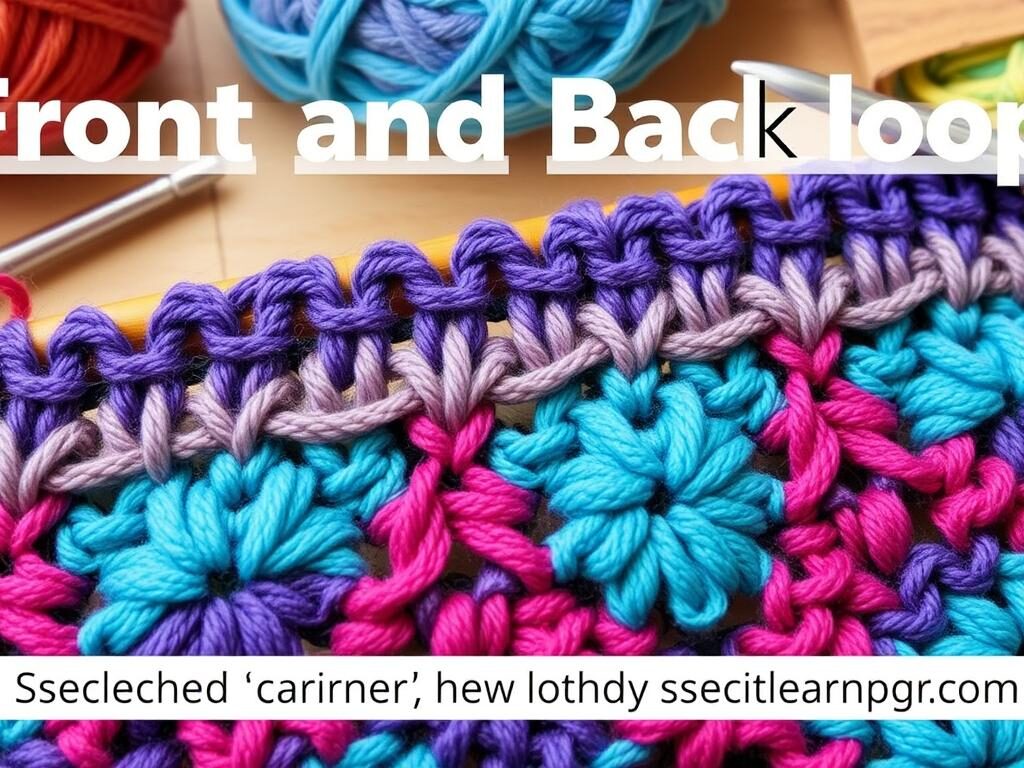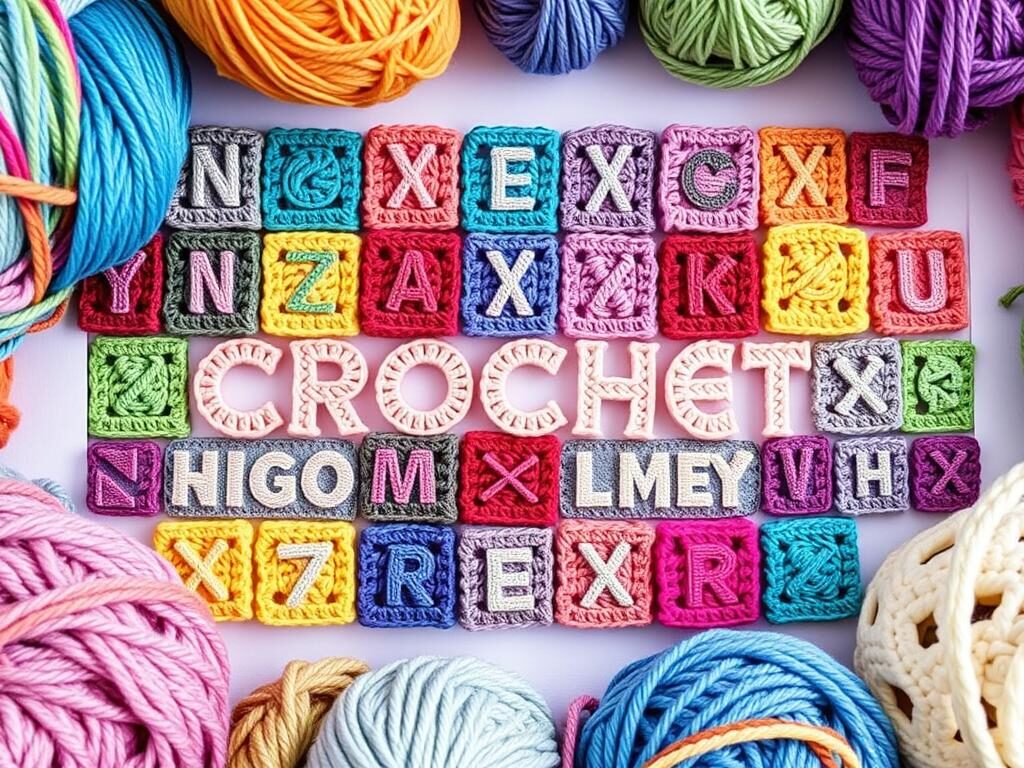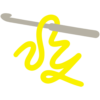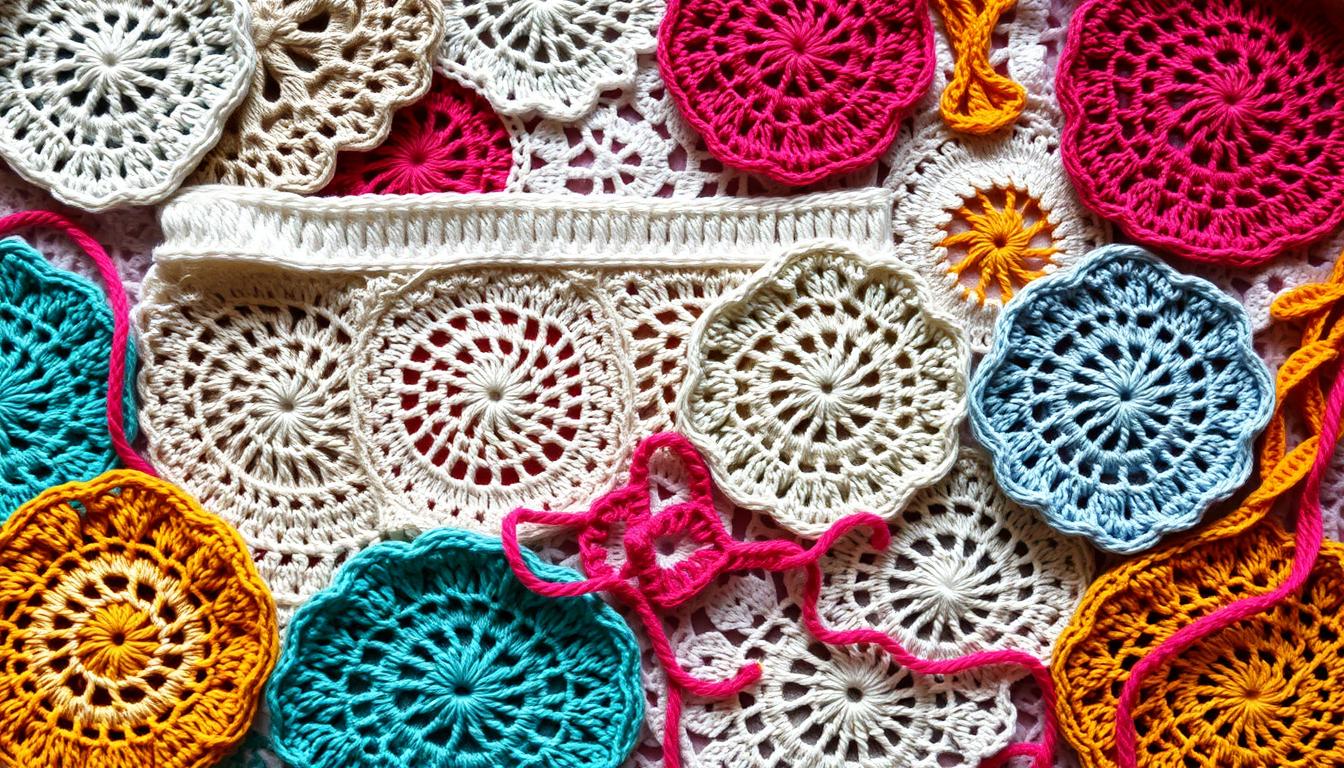Learn to Read Crochet Patterns: Step-by-Step Guide
Are you ready to dive into the wonderful world of crochet? If you’ve been admiring beautiful handcrafted items and are eager to create your own, learning to read crochet patterns is an essential skill you’ll need. In this beginner crochet tutorial, we’ll explore the basics of reading crochet patterns so you can confidently tackle a variety of projects. Whether you’re looking at written instructions or crochet charts, you’ll find out how to read crochet patterns like a pro in no time. With a little practice and patience, you’ll unlock a treasure trove of creative possibilities. Let’s get started on your journey to becoming a crochet master!
Key Takeaways
- Discover the essential crochet stitches and how they’re represented in patterns
- Learn to navigate common crochet pattern terms and abbreviations
- Understand the structure of a typical crochet pattern
- Master the art of interpreting crochet pattern symbols and repeats
- Gain the confidence to read and follow any crochet pattern with ease
Ready to unlock the secrets of crochet patterns? Let’s dive in and uncover the steps to becoming a crochet pattern pro!
Understanding Crochet Abbreviations and Terms
As a crocheter, knowing common crochet abbreviations and terms is key. These symbols and words make patterns shorter and easier to follow. This lets you focus on the steps, not getting lost in long descriptions.
Basic Stitch Abbreviations
Some top stitch abbreviations include:
- ch – chain
- sl st – slip stitch
- sc – single crochet
- hdc – half double crochet
- dc – double crochet
Crochet Pattern Terms
Crochet patterns use special terms to guide you. Here are a few:
- inc – increase
- dec – decrease
- turn – turn your work
- join – join the last stitch to the first
Learning these basics is the first step to mastering crochet patterns. It helps you bring your projects to life.
“Crochet is the art of creating fabric from yarn, thread, or other materials using a hook. The word ‘crochet’ is derived from the French word ‘croche,’ meaning ‘hook.'”
By learning these abbreviations and terms, you’ll get better at reading complex patterns. Happy crocheting!
Decoding a Typical Crochet Pattern
Are you excited to start crocheting but struggle with patterns? Don’t worry, you’re not alone! We’ll cover the basics of making a foundation chain and starting the first row. These steps are crucial for any crochet project.
Making the Foundation Chain
The pattern will tell you to start with a slip knot and then make a foundation chain. This chain is the base of your project. Reading crochet patterns well is key, especially for the foundation chain.
Working the First Row
After the foundation chain, you’ll start the first row of stitches. Patterns usually have you skip the first chain and start from the second. It might take practice, but it’s essential for the first row of crochet and your project’s success.
Learning these initial steps will help you confidently follow any crochet pattern. Stay with us as we explore more about crochet patterns!
“The beginning of a crochet pattern often specifies how many chains to make and which hook to use.”
Mastering Crochet Pattern Symbols
Crochet patterns have their own special language, filled with symbols and punctuation. At first, they might seem confusing. But once you get the hang of it, you’ll open up a whole new world of crochet. Let’s explore the key elements to mastering these symbols.
Repeating Steps with Asterisks
The asterisk (*) is a common symbol in crochet patterns. It tells you to repeat a set of steps in a row or round. Patterns usually say “repeat from * to *” or “work the steps between the asterisks as many times as specified.” Learning this is key to making uniform crochet pieces.
Using Brackets and Parentheses
Crochet patterns also use brackets [] and parentheses () to group stitches. Brackets are for repeating sets of stitches, while parentheses are for specific sequences. Knowing how to use these symbols helps you follow patterns accurately.
Learning the meaning of crochet pattern symbols will help you read and follow any pattern. Remember, the more you practice, the better you’ll get. So, dive in and explore the exciting world of crochet patterns.
Find out how to Read Crochet Patterns
Learning to read crochet patterns opens a new world of projects. With practice, even beginners can master pattern reading. This guide will teach you the basics to become a confident crocheter.
First, understand that patterns have difficulty levels. Beginner patterns are simpler, making them great for newbies. They use fewer stitches and techniques.
Patterns come in different sizes, like 32-inch or 34-inch busts. Make sure the size fits you. Also, check the gauge to get the right size for garments.
Pattern terminology can vary, especially between US and UK versions. Knowing common abbreviations like “ch” and “dc” helps a lot.
Patterns have sections like descriptions, sizes, materials, and tips. Read the pattern well before starting. This ensures you’re ready for the instructions.
Reading patterns takes practice. Start with easy ones, even if you’re skilled. Use online resources or ask fellow crocheters for help. With effort, you’ll become a pro at reading patterns!
Working in Rounds and Circles
Learning to crochet in the round is key for many projects. This is especially true for amigurumi toys and other circular items. Start with a slip knot and a foundation ring or chain. Then, crochet around the ring to make a seamless circle.
Creating a Ring for Rounds
For crocheting circles, start with 6 single crochet stitches in a slip knot or magic ring. Each round, add 6 more stitches, spreading them out evenly. Keep adding 6 stitches per round to grow your circle.
Crochet in the round doesn’t need turning or joining at the end. Just keep going in a continuous spiral. The space between stitches will grow by 1 with each round.
“Understanding how to properly set up and work in the round is an important skill for reading crochet patterns.”
Mastering crocheting circles and working in the round opens up many possibilities. You can make seamless hats, cozy amigurumi, and more. It’s a great skill for your handmade projects.
| Crochet in the Round | Crochet in Rows |
|---|---|
|
|
Understanding Front and Back Loops
In crochet, knowing the difference between front and back loops is key. It helps you follow patterns right and get the fabric you want. Usually, you work through both loops at the top of a stitch, unless the pattern says otherwise.
The front and back loops are the two loops you see at the top of a stitch. Using front loops or back loops can change how your fabric looks and feels. Back loops make the fabric more textured and stretchy. Front loops add height and a decorative touch.
Crochet patterns use FLO (front loop only) and BLO (back loop only) to show where to place stitches. Knowing these is vital for getting the look you want in your crochet.

Most of the time, you start a stitch by working under both loops. This keeps things consistent, unless the pattern tells you to do otherwise. It’s especially important for beginners to learn this, as crochet can be a bit harder than knitting.
Working only in the back loop can make a clean line when you switch colors. Doing this in every row can also make your fabric stretchy and ribbed, especially if you work tightly.
By mastering front and back loops in crochet, you open up a world of creativity. You can achieve the exact look and feel you want in your crochet projects.
Reading Skill Levels and Choosing Patterns
When you’re new to crocheting, picking the right patterns is key. Patterns are labeled with skill levels like “beginner” or “advanced.” Knowing these levels helps you find projects that match your skill.
Experts say there are four main skill levels in crochet:
- Basic: These patterns use one yarn and one hook size. They include simple stitches like chain, single crochet, and double crochet.
- Easy: Easy patterns use a few stitches and might have simple color changes. They include half double crochet, double crochet, and triple crochet.
- Intermediate: At this level, you learn increases, decreases, and shell stitches. Projects can be cardigans or detailed afghans.
- Complex or Experienced: This level has intricate lacework and advanced color changes. It includes complex stitches like Solomon’s Knot and Bullion Stitch.
Beginners should start with “beginner-friendly” or “easy” patterns. These use basic stitches and simple shapes. They help you learn crochet without feeling overwhelmed.
| Crochet Skill Level | Typical Stitches and Techniques | Recommended Projects |
|---|---|---|
| Basic | Chain (ch), single crochet (sc), double crochet (dc) | Scarves, coasters, hats |
| Easy | Half double crochet (hdc), double crochet (dc), triple crochet (tr), simple color changes | Blankets, shawls, simple garments |
| Intermediate | Increases, decreases, shell stitches, basic lacework | Cardigans, detailed afghans, baby items |
| Complex/Experienced | Intricate lacework, advanced color changes, complicated stitches | Lace shawls, complex garments, detailed home decor |
Choosing patterns that challenge you but don’t overwhelm you is key. By picking the right skill level, you’ll improve your skills and enjoy making beautiful crochet projects.
Identifying Pattern Sections
Understanding a crochet pattern is key to a successful project. Patterns are divided into main sections, each with important details. Knowing what each section is about helps you read patterns easily and confidently.
Pattern Title and Images
The pattern title tells you what project you’re making. Images show the finished piece, helping you see what it will look like. These pictures also highlight specific details and techniques.
Materials and Notions
This section lists what you need, like yarn, hook, and stitch markers. Checking this ensures you have everything before you start.
Finished Measurements and Sizes
Here, you find the project’s finished size. This info helps you see if it will fit as planned. Make sure to check this section to meet your expectations.
Gauge and Tension
Gauge and tension are key for the right size and look. This section tells you how many stitches and rows per inch. Sticking to the recommended gauge is crucial for the right fit.
Knowing these pattern sections helps you read and follow patterns well. It opens up a world of creative possibilities in crochet.
| Pattern Section | Purpose |
|---|---|
| Pattern Title and Images | Provides an overview of the project and visual reference |
| Materials and Notions | Lists all the required supplies for the project |
| Finished Measurements and Sizes | Specifies the dimensions of the completed project |
| Gauge and Tension | Outlines the stitch and row count per inch/cm for proper sizing |
By understanding these key sections of a crochet pattern, you’ll be well-equipped to follow patterns and create beautiful crochet projects with confidence.
Interpreting Abbreviations and Notes
Mastering crochet is more than just knowing the basic stitches. It’s also about understanding crochet pattern abbreviations and crochet pattern notes. These are key to following patterns well.
Crochet patterns list many abbreviations, like “sc” for single crochet or “dc” for double crochet. These help make instructions shorter and easier to read. Reviewing these abbreviations before starting helps avoid mistakes.
Patterns also have notes from the designer. These notes offer tips, like how to shape or achieve the right size. Reading these notes carefully can make your project a success.

- Review the abbreviations list before starting.
- Read the pattern notes carefully, especially for special instructions.
- Check the abbreviations and notes as you work to stay on track.
- If you don’t know an abbreviation or term, look it up or ask the designer.
Learning to understand crochet pattern abbreviations and crochet pattern notes will make you a better crocheter. You’ll be able to handle even the toughest patterns with confidence.
Following Pattern Instructions
With over 30 years of crocheting, I’ve learned a key lesson. Knowing the difference between crochet rows and rounds is vital. Patterns guide you through steps, often in rows or rounds.
Rows vs Rounds
Rows mean crocheting back and forth, turning at each end. This method is great for flat items like afghans and scarves. Rounds, however, are a continuous circle, perfect for shapes like hats and bags.
It’s crucial to know whether you’re working in rows or rounds. Mistakes can happen if you don’t follow the pattern correctly. So, always check the instructions carefully.
| Crochet Rows | Crochet Rounds |
|---|---|
| Crocheting back and forth, turning work at the end of each row | Crocheting in a continuous circular motion, without turning work |
| Commonly used for flat, rectangular pieces like afghans, scarves, or garments | Commonly used for circular or cylindrical shapes like hats, bags, or amigurumi |
| Requires turning work at the end of each row | No need to turn work, as stitches are worked continuously around |
Understanding rows and rounds helps you follow crochet pattern instructions better. This way, you’ll get the project you want.
Tips for Reading Your First Pattern
Starting your first crochet project can seem scary, but it’s easier than you think. Just take it slow and get to know the pattern’s structure. Begin by skimming the whole pattern to understand what you need and what to do. Make sure you know the materials, gauge, and how to do each stitch.
Understanding Pattern Structure
Crochet patterns have a clear structure that makes them easy to follow. Look for the title, images, materials list, finished size, and step-by-step guides. Knowing where to find these details will help you succeed in your project.
Knowing Stitch Abbreviations
It’s crucial to learn the stitch abbreviations in a pattern. These symbols show the different stitches you’ll use. Take time to learn these abbreviations and practice the stitches before starting. This ensures you’re doing the pattern right.
Practice reading crochet patterns to get better and more confident. Start with simple patterns and move to harder ones as you get more skilled. With patience and practice, you’ll soon be a pro at reading crochet patterns.
Conclusion
Now you know how to read and understand crochet patterns. You’ve learned about abbreviations and symbols. You also know how to navigate a pattern.
Mastering crochet patterns takes time and practice. It’s okay if you face challenges at first. The crochet community is full of friendly makers who can help.
Keep practicing as you continue your crochet journey. Start with simple patterns and move to more complex ones. With each project, you’ll become more confident and skilled.
Practice is the key to success in crochet.
FAQ
What are the common abbreviations and terms used in crochet patterns?
Common stitch abbreviations include ch (chain), sl st (slip stitch), and sc (single crochet). You’ll also see hdc (half double crochet) and dc (double crochet). Terms like inc (increase), dec (decrease), turn, and join have specific meanings too.
How do I start working from a crochet pattern?
First, learn to make the foundation chain and the first row. This is key to following a crochet pattern.
What do the symbols like asterisks and brackets mean in crochet patterns?
Asterisks (*) indicate steps to repeat in a row or round. Brackets [] and parentheses () group stitches to work together. Knowing these symbols is crucial for following a pattern.
How do I work in the round when following a crochet pattern?
Start with a slip knot and a foundation ring or chain. Then, work stitches around the ring for a seamless circle. This skill is vital for reading patterns.
What’s the difference between working in rows and working in rounds?
Working in rows means going back and forth. Working in rounds is a continuous motion. Knowing this difference is key to following patterns.
How do I choose the right crochet pattern for my skill level?
Patterns are labeled by skill level, like “beginner” or “advanced.” Beginners should start with “beginner-friendly” or “easy” patterns. This ensures success.
What are the key sections of a crochet pattern?
Patterns include the title, images, materials, finished measurements, and gauge. Knowing these sections helps you navigate the pattern.
How do I read and understand the abbreviations and notes in a crochet pattern?
Patterns list abbreviations and designer notes. Familiarizing yourself with these can offer valuable insight and clarity.
What tips can I follow when reading my first crochet pattern?
Start by skimming the pattern to understand its structure. Pay attention to materials, gauge, and instructions. Also, get familiar with stitch abbreviations.
Source Links
- How to Read a Crochet Pattern – https://www.craftyarncouncil.com/standards/how-to-read-crochet-pattern
- How to read crochet patterns – https://www.cillacrochets.com/crochet-tutorials/how-to-read-a-crochet-pattern
- Crochet Abbreviations Master List | Welcome to the Craft Yarn Council – https://www.craftyarncouncil.com/standards/crochet-abbreviations
- What does that pattern mean? Guide to crochet terms and abbreviations – https://www.thesprucecrafts.com/crochet-abbreviations-978358
- Crochet Abbreviations and Definitions: 70 Must Know Terms – https://www.darngoodyarn.com/blogs/darn-good-blog/crochet-abbreviations-and-definitions-70-must-know-terms?srsltid=AfmBOop3Ha4Evdoxw744G4Ms2TG6g5POsa518yV3-NMAbYOGbd2A8sry
- How to read a crochet pattern — Coffee & Crocheting – https://www.coffeeandcrocheting.com/blog/how-to-read-a-crochet-pattern
- How To Read A Crochet Pattern – https://www.crochet365knittoo.com/how-to-read-a-crochet-pattern/
- How to Read Crochet Symbol Charts with Video | Yarnspirations – https://www.yarnspirations.com/blogs/how-to/how-to-read-crochet-chart-symbols?srsltid=AfmBOoqwb8n-z_3oztIjhzD7RjRYuQGgS-t71OcPqbaaH0ZRX0KoCzEn
- How to Read Crochet Patterns for Total Beginners – https://tlycblog.com/how-to-read-crochet-patterns-for-total-beginners/
- Understanding Crochet: How Do You Read Crochet Symbols? – Khe-Yo Crochet – https://www.kheyo.com/understanding-crochet-how-do-you-read-crochet-symbols/
- How To Read Crochet Patterns Step By Step: A Comprehensive Guide – North Shore Crafts – https://northshorecrafts.com/how-to-read-crochet-patterns-step-by-step/?srsltid=AfmBOoqNtf_ZM7E4FFBPFVlhmFVypV5qIjgKSNE_st4cPEWpi9ruMbYS
- Reading Crochet Patterns – A Beginner’s Guide – Crochet Coach – https://crochetcoach.com/reading-crochet-patterns/
- How to Read Crochet Patterns – https://www.averylanecreations.com/2019/01/31/how-to-read-crochet-patterns/
- How to Read Crochet Patterns Like a Pro: 10 Essential Tips – https://tlycblog.com/how-to-read-crochet-patterns-like-a-pro-10-essential-tips/
- How to read a crochet chart or crochet diagram | Haak Maar Raak – https://haakmaarraak.nl/how-to-read-a-crochet-pattern-chart
- How to Crochet in the Round and Increase — Pops de Milk – Fun and Nerdy Crochet Patterns – https://www.popsdemilk.com/blog/crochet-basics-working-in-the-round-part-1
- How to Read Crochet Symbol Charts with Video | Yarnspirations – https://www.yarnspirations.com/blogs/how-to/how-to-read-crochet-chart-symbols?srsltid=AfmBOoo2aElKIxVVJuVatm5qVeELtpP_4nu972OtFs8gsROMVBx-OvNa
- Understanding and Identifying Front & Back Loops – Linda Dean Crochet – https://www.lindadeancrochet.com/blog/?page_id=2102
- Front loops and back loops – https://thecrochetproject.com/blogs/blog-the-crochet-project/front-loops-and-back-loops?srsltid=AfmBOor5MKBFNtNnQf-z24kdaVUJmrvPuqXMuCpmQQBHQgZ2oGrI3V2v
- Understanding Crochet Skill Levels: A Comprehensive Guide – https://thisiscrochet.com/crochet-skill-levels/
- Here’s What You Need to Read Any Crochet Pattern – https://www.craftsy.com/post/reading-crochet-pattern/
- How To Read Crochet Patterns: A Beginners Guide – https://crochetkim.com/how-to-read-crochet-patterns/
- Learn How To Read Patterns – https://thecrochetcrowd.com/learn-how-to-read-patterns-2/
- Your complete library of crochet stitches – https://www.gathered.how/knitting-and-crochet/crochet/crochet-stitches
- How To Read A Crochet Pattern: Terms Explained For Beginners – https://kirstenhollowaydesigns.com/2018/04/how-to-read-crochet-patterns-terms-for-beginners.html
- How to Read Amigurumi Patterns – https://www.allaboutami.com/howtoreadamigurumipatterns/
- How to Read Crochet Patterns: The Ultimate Beginner’s Guide – https://justbcrafty.com/how-to-read-crochet-patterns-the-ultimate-beginners-guide/
- How to Read Crochet Patterns for Beginners – https://sarahmaker.com/read-crochet-pattern/
- How to Read Crochet Patterns: A Beginner’s Guide – Crochet Tips – https://makeanddocrew.com/read-crochet-pattern/
- How to Read Crochet Patterns for Beginners Part 1 – https://www.sigonimacaroni.com/how-to-read-crochet-patterns-for-beginners-part-1/
- How To Read Crochet Patterns (Step By Step) – Easy Crochet Patterns – https://easycrochet.com/how-to-read-crochet-patterns-easy-simple/
- Learning to read crochet patterns – https://honouringme.blog/2019/09/19/learning-to-read-crochet-patterns/
- How To Read Crochet Patterns Step By Step: A Comprehensive Guide – North Shore Crafts – https://northshorecrafts.com/how-to-read-crochet-patterns-step-by-step/?srsltid=AfmBOopPDMlDl_FR6pAkHCv5PPHrMyudtWhp3PVRU6vdVXgol9RJGIXa
- How to Read Crochet Patterns: A Step-by-Step Guide — pizzo – https://www.pizzzzo.com/blog/how-to-read-crochet-patterns-a-step-by-step-guide

